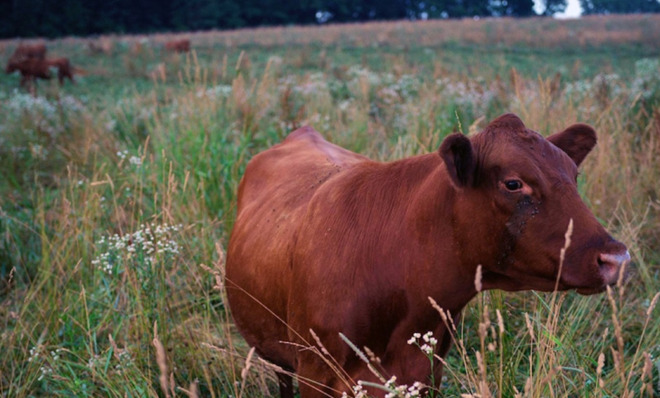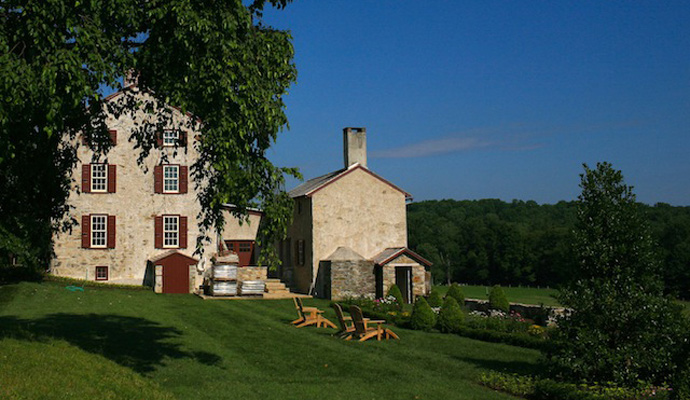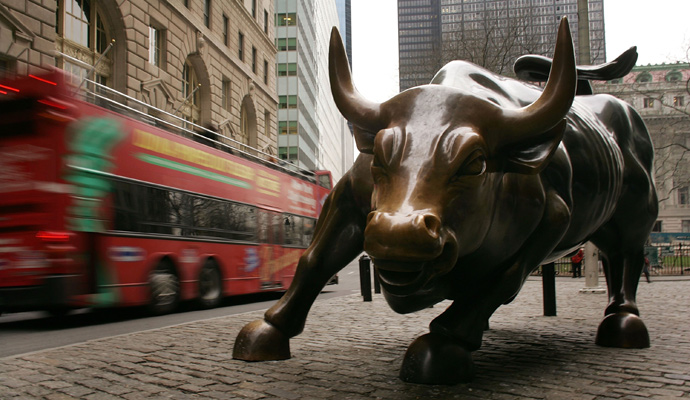The financialization of food
For decades, banks shied away from investing in farms. Not anymore.


Just off of Country Road 518 in Hopewell, New Jersey, sits Double Brook Farm. It's run by a self-exiled New Yorker but it's not one of those now-standard upstart farms, with roving bands of earnest college kids tending rocket and a hearty couple of ex-Brooklynites overseeing the whole grass-fed operation. Double Brook's turn-of-the-century barn, its grazing cattle, and its hundreds of Rhode Island Reds clucking and strutting about all belong to Jon McConaughy, a 46-year-old with an all-American face, a football player's build, and a beautiful wife. Last year, McConaughy exchanged a two-decade-long career as a commodities trader on Wall Street for these two hundred acres.
Double Brook, a small farm specializing in grass-fed meat, free-range poultry and sun-dried vegetables, symbolizes one of the most unexpected turns the American economy has taken in recent years. For decades, banks have shied away from granting loans to farmers because, like restaurants, they are considered risky investments. But the tides might be turning as the price of nearly every commodity on the face of the earth is on the rise.
"Farming is the new 'good investment,'" says McConaughy, who grew up in the dairy country of rural New Jersey, only five miles from Double Brook. "I always knew I was going to return to the farm. But I am not the only banker-turned-farmer — it's a trend."
The Week
Escape your echo chamber. Get the facts behind the news, plus analysis from multiple perspectives.

Sign up for The Week's Free Newsletters
From our morning news briefing to a weekly Good News Newsletter, get the best of The Week delivered directly to your inbox.
From our morning news briefing to a weekly Good News Newsletter, get the best of The Week delivered directly to your inbox.
(More from Narratively: You've been served)
Last month I met Dean Carlson, another member of the growing sect of Wall Streeters gone AWOL, at a TEDx talk in Phoenixville, Penn. Carlson's 17-minute presentation was one of the most powerful I have ever witnessed. In it, he explained the Rule of Seventy, a method commonly used in finance to estimate the time it will take for an investment to double. Divide 70 by the projected annual growth rate and you get the number of years it will take for the growing thing to be twice as big. An economy with a 10 percent growth rate, for instance, will double in seven years' time. As with any exponential function, the base variable (the economy in this case,) must grow bigger and bigger at an ever-increasing rate. Two hundred years down the line, if that same economy keeps growing at 10 percent per year, it will be 500 times as big as it is today, and 207 years down the line it will be a thousand times its original size. When Carlson applied the Rule of Seventy to food production he became scared, if not paralyzed, with fear.
Like McConaughy, Carlson traded his three-piece suit for some dungarees and a whole bunch of cattle. He purchased Weybrook Farm, which rests in the verdant swath of land just northwest of Philadelphia known as Chester County, in 2009.
Carlson has a quiet way about him, a lip that turns slightly up at the corner, and a slow drawl that makes you think he has spent his entire life tending farm animals. When I asked Carlson, who is in his mid-40s, why he chose to invest in livestock and years of hard labor, his reasons were straightforward enough. "Exponential growth, the idea of having to consume more to keep our economy afloat, always bugged me," he told me. "It can't hold. I figured it out over time. Then I watched the 2009 bailout happen and saw the depth to which we would defend that very idea. Right around then I was reading The Omnivore's Dilemma. I saw that food costs are going to go up, and how do you protect yourself against that? After 20 years on Wall Street I knew this much: An individual can't get involved in the financial side of things because the game is rigged in favor of the banks. The only thing I came up with was to get involved in farming itself. "
A free daily email with the biggest news stories of the day – and the best features from TheWeek.com

* * *
You may have heard it before: Food is the next bubble. Between 2002 and 2008, the price of wheat nearly quadrupled, rising from three to 11 dollars a bushel. According to the senior economist for the U.N.'s Food and Agricultural Organization, the cost of food has increased, on average, 50 to 60 percent a year in recent years, forcing many in poor countries to spend half their take-home pay to put food on the table. With food prices doubling every two years in some places, a bag of rice that costs a dollar today will cost five and a half dollars in four years and $41 in 2022.
But what does this Food Bubble look like? In Egypt, food riots turned into the toppling of Murbarak in 2011, and in Bangladesh three years earlier, tens of thousands of textile workers demanded higher salaries to meet the skyrocketing cost of food. Here, however, in our own backyards, grain subsidies shield American consumers from feeling the crushing price of wheat. But the relative safe remove from which we view this crisis will not last forever.
Four years ago, Dr. Frederick Kaufman, a specialist in food systems and Americans' historic habits of culinary consumption, asked a daunting question for any writer: "What's next?" Kaufman, a longtime resident of Manhattan's financial district, had spent decades writing about eating. He was ready for something new. The answer, according to Kaufman, was obvious. He would have to write about hunger, the ugly flipside of food.
"I was having a lunch meeting with my editor. When we decided on doing a story about hunger, silence descended on us. To be honest, we were afraid. We didn't really want to go there," Kaufman says, recalling that 2008 meeting with his editor at Harper's Magazine. "But it did have that newsiness that a good story needs. There were more people hungry on planet Earth than ever before in 2008, despite it being a bumper year for crops." Kaufman scuffs his shoes along the granite slab sidewalk, tugging at the zipper of his fall leather coat. His flinty blue eyes catch mine, and he stops speaking, waiting for my note-taking to catch up with his rapid speech.
It is October and Kaufman and I are sitting outside the Federal Reserve in Lower Manhattan. A Hollywood Jew of the intellectual sort (his father was a screenwriter twice nominated for Academy Awards,) Kaufman has spent half of his career writing for Harper's. He went on to write that article about hunger, and subsequently published a book, Bet the Farm: How Food Stopped Being Food, in 2012.
(More from Narratively: Food fluffers)
Kaufman, whose general enthusiasm is tempered by a sharp and yet non-aggrandizing intellect, and I are chatting in front of a set of black wooden doors, the likes of which I haven't seen since strolling down the Rue de Lille in Paris. At least 40 feet high, they look like it would take a battering ram to make them budge. The grates covering the Fed's windows are strangely thick — as though the iron has been placed in a microwave and puffed up like a marshmallow. The walls of the Federal Reserve are fashioned from stacked blocks of sandstone and limestone, mixed by York & Sawyer, famous across New England for their Florentine-inspired bank designs. Each stone block is roughly three by five feet. Underground, beneath this behemoth of a building, sits a vault that holds more than $194 billion in gold bricks.
"I brought you here for a reason," Kaufman tells me. "This is 33 Liberty Street, where both money and debt are manufactured." In 2009, the Federal Reserve printed an unprecedented one-and-a-quarter-trillion dollars of new money in a single day, he says. "Out of the bowels of the Fed, more bills magically appeared and they used it to purchase debt–home mortgages, business loans, school loans." The Fed purchased about one-fifth of our county's mortgage-backed securities. "That's what Occupy Wall Street doesn't quite understand," Kaufman adds. "You can't just get rid of debt, of student loans and the like, because money enters the market as debt. That's what it is, at the core."
From this moment forth, every step of my Kaufman-led tour of the increasingly securitized financial district is monitored. Five security guards walk past us while we sit, staring at the double doomsday doors. One cop car cruises by, slow and deliberate. Just across Liberty Street from the Federal Reserve is the corporate headquarters of JP Morgan Chase, recently splashed across headlines when Occupy Wall Streeters dumped five-gallon-buckets of human excrement over the bank's public plaza. The culprits were caught, thanks to surveillance cameras, and in retaliation JP Morgan Chase closed the public plaza at the base of its 60-story-high headquarters.
Kaufman chose to meet me here, on Liberty Street, where the Federal Reserve and one of the biggest banks in the world meet, because he'd come to understand the significance of the interplay between these two entities. Such a relationship, he argues, explains why folks like McConaughy the farmer have given up the Wall Street game, and why people from Dhaka to Cairo are rioting for food.

* * *
Kaufman began his investigation into hunger with what he thought was a relatively easy question: Where does the price of food come from? His foodie friends had no idea. They were interested in slow food, and the traditional curing methods of Tibetan yak farmers. And Kaufman's banker buddies didn't want to go there because, he says, they were afraid of "holding the bag for 900 million starving people." So Kaufman called Daryll E. Ray, director of the Agricultural Policy Analysis Center at the University of Tennessee, who advised him to investigate Commodity Index Funds.
Over the past twenty years, Wall Street has become increasingly invested in America's food production. It started with the invention of the Commodity Index Fund (CIF) by Goldman Sachs in 1991, which allows bankers to buy and sell shares of wheat, soy, cottonseed, and corn oil futures (among countless others) as if they were Apple stock. Most of the big banks involved in the real estate bubble — JP Morgan Chase, Barclays, Morgan Stanley — have their own unique CIFs, which have provided them with billions of dollars in relatively risk-free investments that they hedge and move around to turn a profit.
(More from Narratively: Grown in Staten)
"Commodities are a futures market," Kaufman explained, noting that it took him "almost a year to figure out how futures work." He broke it down for me into the four most basic components:
One, we have a need every day for products that only come out of the earth once, maybe twice a year. It's feast or famine and the cost of these goods once was dependent upon where we are in the growing cycle.
Two, civilization — philosophers, doctors, teachers, and all of us city-dwellers — we need easy access to food year-round.
So we arrive at the third truth, which leads to a futures market — the need for price stabilization for all of us, farmers and city dwellers alike, to survive. If wheat costs one dollar a bushel in autumn and 100 dollars a bushel in winter, no one is happy.
Kaufman went on to describe the actual invention of a futures contract, which he compared to a promissory note that guarantees the future purchase of a select commodity at a set price, often a tiny bit lower than the current going rate.
"Everyone knows the risks involved," he told me. "And everyone is buying and selling and trading, and traditionally the market itself is kosher, because everyone involved is playing by the rules. The purchases and the sales equal each other out, thus stabilizing the price."
But over the past two decades, commodities markets have undergone a veritable sea-change. As with almost everything Goldman Sachs touches, their CIF was an overnight sensation, leading other banks to concoct their own unique CIF elixirs, each placing a slightly different weight on their chosen commodities. Thomson Reuters, for example, invests five percent of its fund in coffee, six percent in corn, six percent in live cattle, six percent in natural gas, one percent in orange juice, five percent in sugar, and so on. Each fund's dispersal of investments is unique. While commodities markets have traditionally had space for speculators who provide liquidity on which farmers rely to keep their businesses afloat, CIFs siphoned more money into commodities than ever before. By 2007, the CIF phenomenon was snowballing — some might say out of control.
Read the rest of this story at Narratively.
Narratively is an online magazine devoted to original, in-depth and untold stories. Each week, Narratively explores a different theme and publishes just one story a day. It was one of TIME's 50 Best Websites of 2013.
-
 5 fairly vain cartoons about Vanity Fair’s interviews with Susie Wiles
5 fairly vain cartoons about Vanity Fair’s interviews with Susie WilesCartoon Artists take on demolition derby, alcoholic personality, and more
-
 Joanna Trollope: novelist who had a No. 1 bestseller with The Rector’s Wife
Joanna Trollope: novelist who had a No. 1 bestseller with The Rector’s WifeIn the Spotlight Trollope found fame with intelligent novels about the dramas and dilemmas of modern women
-
 Codeword: December 20, 2025
Codeword: December 20, 2025The daily codeword puzzle from The Week